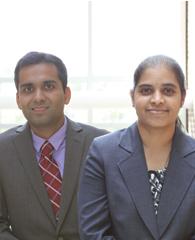CTM, FDA Collaborate to Assess Extrapolation of Anti-Epileptic Drugs’ Effectiveness
FDA praises the Center’s efforts to bring academic, government, and industry stakeholders together for collaborative project with wide-reaching implications.

By Malissa Carroll
March 24, 2016
A collaborative research project led by the Food and Drug Administration (FDA) with support from the Center for Translational Medicine (CTM) at the University of Maryland School of Pharmacy and the Pediatric Epilepsy Academic Consortium for Extrapolation (PEACE) has concluded that extrapolation of anti-epileptic drug efficacy results from adults to children ages four years and older with partial onset seizures is acceptable, and that independent clinical trials for efficacy in children will no longer be needed.
“The CTM works with organizations around the world to streamline drug development through the continuous assessment of current practices, with the goal of developing and implementing new, more efficient drug development processes,” says Joga Gobburu, PhD, MBA, professor in the Department of Pharmacy Practice and Science (PPS) and director of the CTM at the School. “In the field of pediatric drug development, we know that performing clinical trials in the pediatric patient population is challenging for a number of reasons. Through this collaborative research project, we sought to determine whether additional clinical trials are truly necessary to show efficacy of anti-epileptic drugs in children once other trials have shown those drugs to be effective in adults.”
Anti-epileptic drugs refer to a diverse group of medications used to treat various types of epileptic seizures. These medications are often developed as supplemental therapy to treat partial onset seizures – the most common type of seizure experienced by patients with epilepsy – in adults. Prior to the completion of this project, these medications were only prescribed to pediatric patients after they had been approved for use in adults and at least one well-controlled clinical trial had been conducted in pediatric patients.
To assess whether the accumulated evidence from past clinical trials with multiple anti-epileptic drugs was sufficient to support extrapolation of efficacy from adult to pediatric patients for the treatment of partial onset seizures, and under what circumstances such extrapolation would be appropriate, the FDA turned to the CTM. Gobburu reached out to PEACE – a consortium that includes experts from a number of organizations external to the FDA, including academia and the pharmaceutical industry – to provide supportive clinical expertise in describing disease and intervention similarities between adult and pediatric patients.
“PEACE was established in 2012, and includes representatives from numerous organizations across academia, government, and industry,” says John Pellock, MD, a member of PEACE and professor and senior associate dean of continuing medical education at Virginia Commonwealth University School of Medicine. “When Dr. Gobburu first introduced the project to the consortium, we recognized its relevance to the work that we do every day, and were excited to get involved. The child neurologists in the consortium were instrumental in assessing the similarity of focal epilepsy in adults and children, while Dr. Gobburu led other members in further pharmacometric analyses in conjunction with the FDA.”
Funded by the FDA’s Center for Drug Evaluation and Research Critical Path program, the project required screening all approved anti-epileptic drugs to identify those for which efficacy clinical trials had been conducted in both adult and pediatric patients for supplemental therapy of partial onset seizures. Quantitative pharmacokinetic (PK) and pharmacokinetic/pharmacodynamics (PK/PD) analyses were then conducted for PK/PD and clinical endpoints datasets collected from both FDA databases and the pharmaceutical companies. Shailly Mehrotra, a graduate student mentored by Gobburu in the PhD in Pharmaceutical Sciences (PSC) program at the School, was afforded the unique opportunity to gain hands-on experience analyzing the data at the FDA, where she assisted with the creation of a clinical trial database and performed exposure-response analyses to bridge partial onset seizures’ supplemental treatment data between adult and pediatric patients.
“I am grateful to the CTM for offering me the opportunity to complete a fellowship with the FDA,” says Mehrotra. “The CTM has played a pivotal role in providing me with excellent training to help hone my technical skills, while helping to elucidate complex drug development concepts that I will be able to apply towards influencing decisions.”
She adds, “As a graduate student, it was a unique experience to work with the immensely talented scientists at the FDA, as well as the brilliant clinicians from PEACE. I feel fortunate to have been involved in a project that directly impacted public health and patient care through accelerating the pediatric drug development of anti-epileptic drugs. Not only did this fellowship provide a platform to help me further develop my core skills as a researcher, but – more importantly – it also provided me with a broad overview of pediatric drug development. It taught me how innovative, out-of-the-box thinking, combined with team collaborations can help tackle challenging problems. The lessons that I learned during my fellowship at the FDA, coupled with the meticulous training that I have received at the CTM, have truly laid a strong foundation for my professional career.”
Based on the analyses conducted by Mehrotra and other researchers, the FDA concluded that extrapolation of efficacy from adult to pediatric patients ages four years and older with partial onset seizures is acceptable.
“The FDA thanks Dr. Gobburu for his truly pivotal role in bringing together external collaborators to work with our agency on this project,” says Mehul Mehta, PhD, FAAPS, director of the Division of Clinical Pharmacology I in the Office of Clinical Pharmacology at the FDA. “Those rich collaborations, combined with Shailly’s exhaustive and complex analysis of a large number of clinical trials, helped to form the backbone for the success of this project.”
Echoing Mehta’s sentiment, Gobburu notes that it was the level of collaboration that occurred between the FDA, CTM, and PEACE throughout the project that made the initiative exceptionally trailblazing. “Putting the outcome of the project aside, it was the collaborative process in which all of the stakeholders engaged that helped to make this project a success. This project brought together a consortium, an academic institution, and the FDA to solve a common problem, creating a template for teamwork that we can implement across other projects. It is very fulfilling to know that our Center and the School of Pharmacy were instrumental in bringing all of the parties together to make this happen.”



